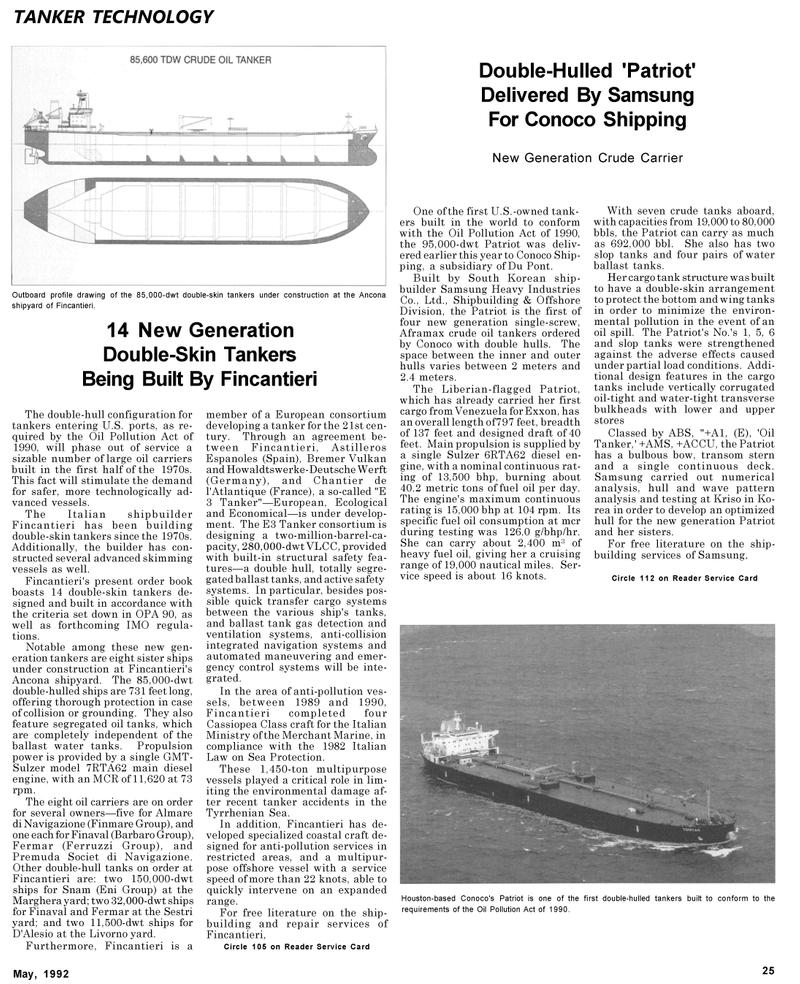
Page 25: of Maritime Reporter Magazine (May 1992)
Read this page in Pdf, Flash or Html5 edition of May 1992 Maritime Reporter Magazine
TANKER TECHNOLOGY
Double-Hulled 'Patriot'
Delivered By Samsung
For Conoco Shipping
New Generation Crude Carrier
Outboard profile drawing of the 85,000-dwt double-skin tankers under construction at the Ancona shipyard of Fincantieri. 14 New Generation
Double-Skin Tankers
Being Built By Fincantieri
The double-hull configuration for tankers entering U.S. ports, as re- quired by the Oil Pollution Act of 1990, will phase out of service a sizable number of large oil carriers built in the first half of the 1970s.
This fact will stimulate the demand for safer, more technologically ad- vanced vessels.
The Italian shipbuilder
Fincantieri has been building double-skin tankers since the 1970s.
Additionally, the builder has con- structed several advanced skimming vessels as well.
Fincantieri's present order book boasts 14 double-skin tankers de- signed and built in accordance with the criteria set down in OPA 90, as well as forthcoming IMO regula- tions.
Notable among these new gen- eration tankers are eight sister ships under construction at Fincantieri's
Ancona shipyard. The 85,000-dwt double-hulled ships are 731 feet long, offering thorough protection in case of collision or grounding. They also feature segregated oil tanks, which are completely independent of the ballast water tanks. Propulsion power is provided by a single GMT-
Sulzer model 7RTA62 main diesel engine, with an MCR of 11,620 at 73 rpm.
The eight oil carriers are on order for several owners—five for Almare di Navigazione (Finmare Group), and one each for Finaval (Barbaro Group),
Fermar (Ferruzzi Group), and
Premuda Societ di Navigazione.
Other double-hull tanks on order at
Fincantieri are: two 150,000-dwt ships for Snam (Eni Group) at the
Marghera yard; two 32,000-dwt ships for Finaval and Fermar at the Sestri yard; and two 11,500-dwt ships for
D'Alesio at the Livorno yard.
Furthermore, Fincantieri is a member of a European consortium developing a tanker for the 21st cen- tury. Through an agreement be- tween Fincantieri, Astilleros
Espanoles (Spain), Bremer Vulkan and Howaldtswerke-Deutsche Werft (Germany), and Chantier de l'Atlantique (France), a so-called "E 3 Tanker"—European, Ecological and Economical—is under develop- ment. The E3 Tanker consortium is designing a two-million-barrel-ca- pacity, 280,000-dwt VLCC, provided with built-in structural safety fea- tures—a double hull, totally segre- gated ballast tanks, and active safety systems. In particular, besides pos- sible quick transfer cargo systems between the various ship's tanks, and ballast tank gas detection and ventilation systems, anti-collision integrated navigation systems and automated maneuvering and emer- gency control systems will be inte- grated.
In the area of anti-pollution ves- sels, between 1989 and 1990,
Fincantieri completed four
Cassiopea Class craft for the Italian
Ministry of the Merchant Marine, in compliance with the 1982 Italian
Law on Sea Protection.
These 1,450-ton multipurpose vessels played a critical role in lim- iting the environmental damage af- ter recent tanker accidents in the
Tyrrhenian Sea.
In addition, Fincantieri has de- veloped specialized coastal craft de- signed for anti-pollution services in restricted areas, and a multipur- pose offshore vessel with a service speed of more than 22 knots, able to quickly intervene on an expanded range.
For free literature on the ship- building and repair services of
Fincantieri,
Circle 105 on Reader Service Card
One of the first U.S.-owned tank- ers built in the world to conform with the Oil Pollution Act of 1990, the 95,000-dwt Patriot was deliv- ered earlier this year to Conoco Ship- ping, a subsidiary of Du Pont.
Built by South Korean ship- builder Samsung Heavy Industries
Co., Ltd., Shipbuilding & Offshore
Division, the Patriot is the first of four new generation single-screw,
Aframax crude oil tankers ordered by Conoco with double hulls. The space between the inner and outer hulls varies between 2 meters and 2.4 meters.
The Liberian-flagged Patriot, which has already carried her first cargo from Venezuela for Exxon, has an overall length of797 feet, breadth of 137 feet and designed draft of 40 feet. Main propulsion is supplied by a single Sulzer 6RTA62 diesel en- gine, with a nominal continuous rat- ing of 13,500 bhp, burning about 40.2 metric tons of fuel oil per day.
The engine's maximum continuous rating is 15,000 bhp at 104 rpm. Its specific fuel oil consumption at mcr during testing was 126.0 g/bhp/hr.
She can carry about 2,400 m3 of heavy fuel oil, giving her a cruising range of 19,000 nautical miles. Ser- vice speed is about 16 knots.
With seven crude tanks aboard, with capacities from 19,000 to 80,000 bbls, the Patriot can carry as much as 692,000 bbl. She also has two slop tanks and four pairs of water ballast tanks.
Her cargo tank structure was built to have a double-skin arrangement to protect the bottom and wing tanks in order to minimize the environ- mental pollution in the event of an oil spill. The Patriot's No.'s 1, 5, 6 and slop tanks were strengthened against the adverse effects caused under partial load conditions. Addi- tional design features in the cargo tanks include vertically corrugated oil-tight and water-tight transverse bulkheads with lower and upper stores
Classed by ABS, "+A1, (E), 'Oil
Tanker,' +AMS, +ACCU, the Patriot has a bulbous bow, transom stern and a single continuous deck.
Samsung carried out numerical analysis, hull and wave pattern analysis and testing at Kriso in Ko- rea in order to develop an optimized hull for the new generation Patriot and her sisters.
For free literature on the ship- building services of Samsung,
Circle 112 on Reader Service Card
Houston-based Conoco's Patriot is one of the first double-hulled tankers built to conform to the requirements of the Oil Pollution Act of 1990.
May, 1992 25

 24
24

 26
26
